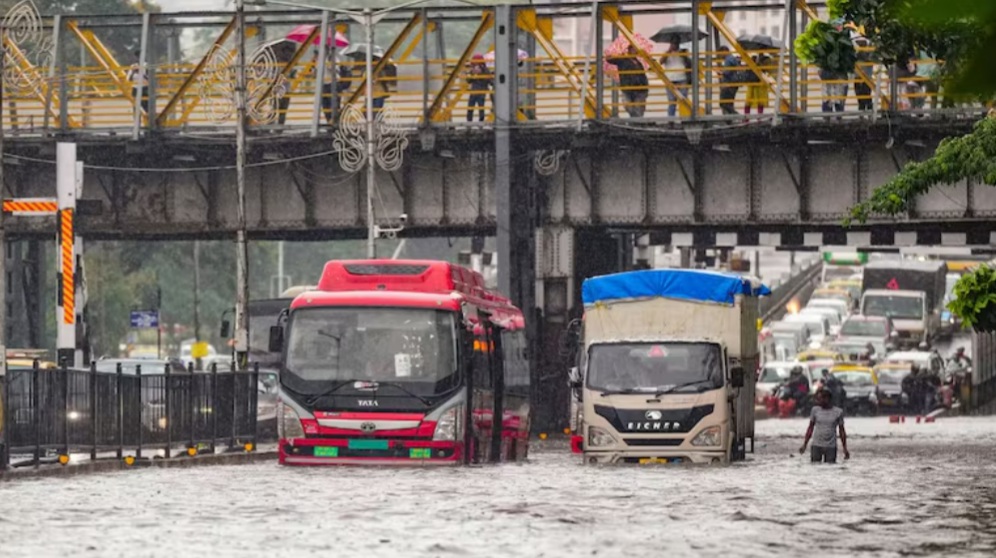Mumbai Rains and subsequent flooding every monsoon season due to a combination of geographical, meteorological, and urban planning factors. While a single “permanent solution” is complex to achieve, various ongoing efforts and proposed strategies aim to mitigate the impact of these rains.

Here’s a breakdown of the causes and potential solutions:
Causes of Flooding in Mumbai:
- Heavy Rainfall: Mumbai Rains means exceptionally heavy rainfall during the monsoon. The pattern has also shifted, with more intense rain concentrated over shorter periods, overwhelming existing systems.
- Topography: Mumbai was originally a collection of seven islands. Land reclamation over time created a continuous landmass but also resulted in low-lying areas that are prone to water accumulation.
- Tidal Influence: Mumbai is a coastal city, and high tides often coincide with heavy rainfall. During high tide, it becomes difficult for rainwater to drain into the Arabian Sea, leading to backflow and increased waterlogging.
- Inadequate Drainage System: The city’s storm water drain system, much of which dates back to the British era, has a limited capacity (designed for 25mm/hour, while the city can receive much more). While the BRIMSTOWAD project aimed to increase this capacity to 50mm/hour, it remains incomplete.
- Encroachment and Concretization: Encroachments on floodplains and the Mithi River’s banks, along with widespread concretization (paved surfaces, roads, and buildings), reduce the land’s ability to absorb rainwater, increasing surface runoff.
- Waste Management: Plastic and other waste often clog drains, further hindering the flow of rainwater.
- Incomplete Pre-Monsoon Work: The early arrival of the monsoon can sometimes disrupt the scheduled desilting and cleaning of drains, leaving the system unprepared.

Ongoing and Proposed Solutions:
1. Underground Water Storage Tanks/Holding Ponds:
- This is a promising solution being actively implemented and studied. The Brihanmumbai Municipal Corporation (BMC) has successfully deployed underground tanks in areas like Hindmata, Pramod Mahajan Kala Park, and St. Xavier’s ground, significantly reducing flooding in those regions.
- The Mumbai Railway Vikas Corporation (MRVC) is partnering with IIT-Bombay for a feasibility study to construct large underground tanks to store excess rainwater, particularly to prevent disruptions to suburban railway services.
- These tanks temporarily store excess water during peak rainfall and then slowly release it into drains or pump it into the sea during low tide.
2. Upgrading and Augmenting Storm Water Drainage Systems (BRIMSTOWAD Project):
- The ongoing BRIMSTOWAD project aims to increase the capacity of storm water drains and install pumping stations at outfalls. While facing challenges like the impossibility of widening drains where building foundations are present, the project is critical for improving drainage.
- There’s a focus on increasing the water-carrying capacity of drains and creating additional drainage lines.
3. Pumping Stations:
- The city has a network of major and mini pumping stations that discharge excess rainwater into the sea, especially during high tides when gravity flow is not possible. More dewatering pumps are being installed in flood-prone areas, some equipped with IoT sensors for real-time monitoring.
4. Mithi River Restoration and Desilting:
- The Mithi River is a crucial storm water discharge channel. Efforts are underway to restore it to its pre-development conditions, including clearing encroachments, desilting, and widening its course. Desilting of other rivers and nullahs (drains) is also an ongoing activity.
5. Blue-Green Infrastructure (BGI):
- This approach involves integrating natural elements into urban planning. Examples include bioswales (ditches with porous soil and plants that absorb and filter runoff), constructed wetlands, and protecting mangroves (which act as natural flood barriers).
- The Mumbai Climate Action Plan (MCAP) acknowledges the need to protect blue and green spaces, though there are concerns about development projects impacting existing green cover.
6. Rainwater Harvesting:
- Encouraging and implementing rainwater harvesting at the building and community level can help recharge groundwater and reduce the burden on drainage systems by capturing water at the source.
7. Improved Urban Planning and Regulations:
- Identifying and earmarking flood-prone zones in development plans, enforcing stricter building codes, and ensuring buffer zones along water bodies are crucial for long-term flood resilience.
- There’s a need to balance urban development with environmental considerations to prevent further concretization and loss of permeable surfaces.
8. Disaster Management and Early Warning Systems:
- Mumbai has a centralized Disaster Control Centre with real-time meteorological and seismic data, hotlines to emergency services, and a network of CCTV cameras. Flood level sensors are installed at rivers and lakes.
- Upgrading flood forecasting to “nowcasting” (short-term, highly accurate forecasts) can help in timely responses.
9. Citizen Participation and Awareness:
- Responsible waste management by citizens is vital to prevent drain clogging. Public awareness campaigns on monsoon preparedness and self-help measures are also important.
While no single measure can be a complete “permanent solution,” a multi-pronged approach combining robust grey infrastructure (drains, pumps, tanks) with blue-green infrastructure, improved urban planning, and active citizen participation offers the most comprehensive path to mitigating Mumbai’s annual flooding challenges.